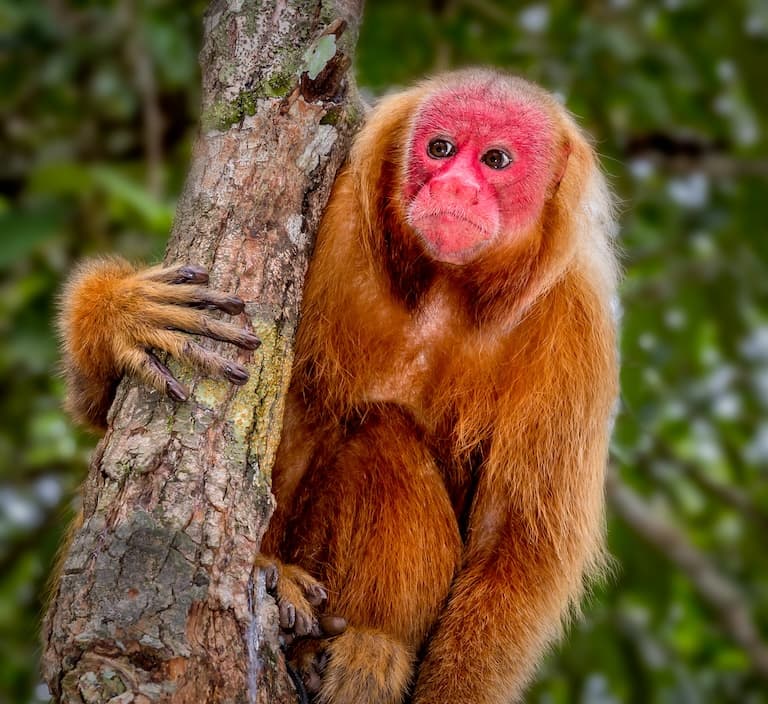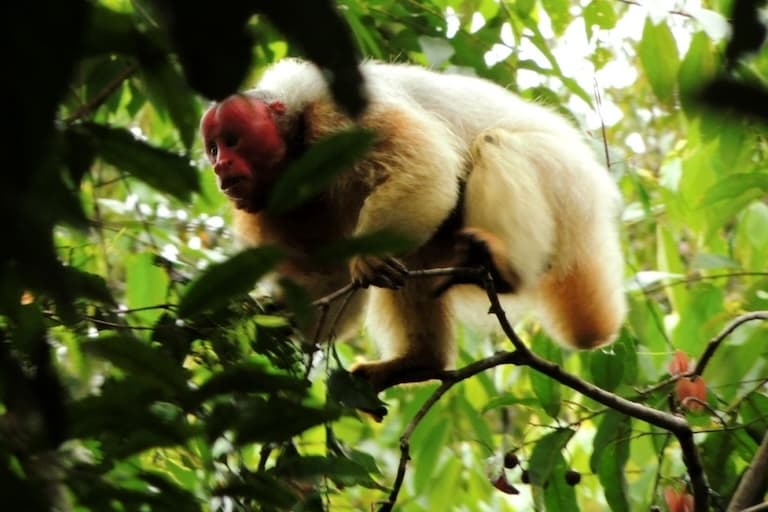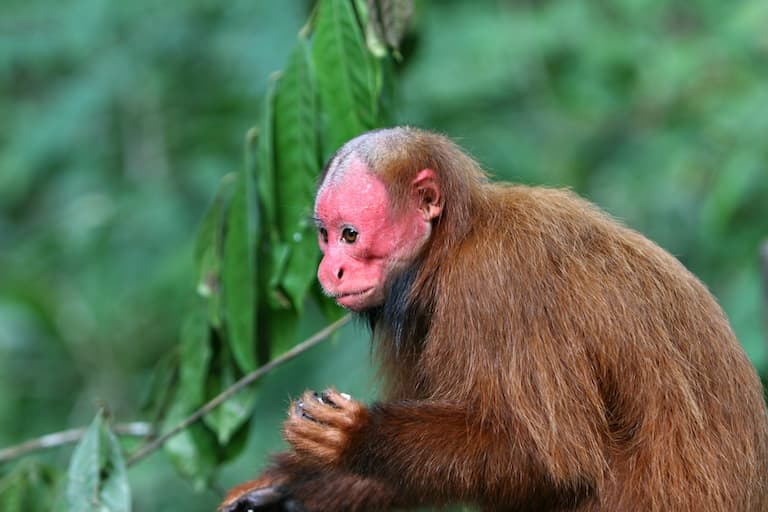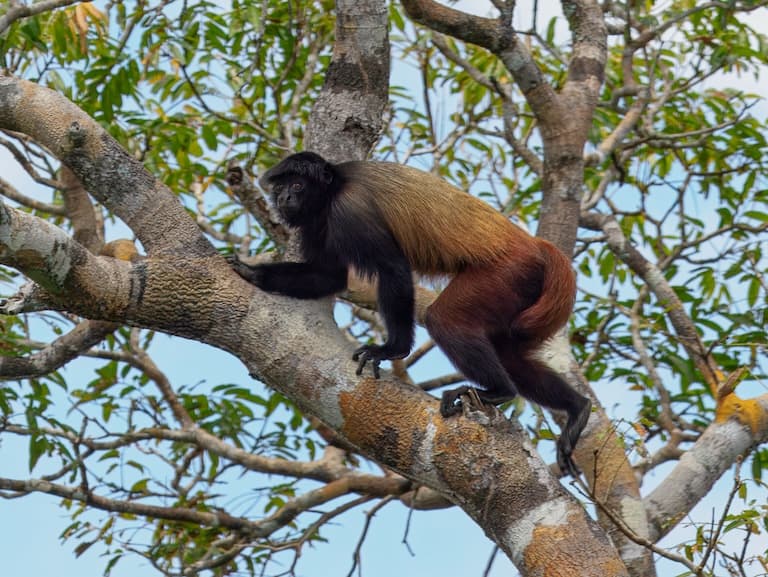Uakari Profile
The Western world is now mostly ruled by bald, pink folks who have overcompensated for their lack of appeal and gone instead for world domination. But perhaps a counterforce can be found in a large genus of New-World monkey, for whom being red in the face is actually pretty sexy.
The Uakaris flip the script: The pink ones get all the attention, while the lesser-known, handsome little fellas are plotting to take over the planet, too.

Uakari Facts Overview
| Habitat: | Forest canopy |
| Location: | South America |
| Lifespan: | 27+ years |
| Size: | Up to around 60 cm in length, the tail is shorter |
| Weight: | Up to 4 kg (9 lb) |
| Colour: | Varied. Some black, some ginger, some blonde. |
| Diet: | Fruit, particularly seeds from unripe fruit; some passive insect consumption |
| Predators: | Raptors and humans |
| Top Speed: | Slow |
| No. of Species: | 7 or 8 |
| Conservation Status: | Most Least Concern, two species are vulnerable |
Despite being so obvious, Uakaris are not all that well understood. What was once a single species has been broken into many, and there are still new ones being found as recently as 2008. They are social, low-aggression animals who seem to just want to be left alone to eat seeds all day. Oh, and they are known for having faces like a baboon’s arse. But as we’ll see, this isn’t the full story!
Interesting Uakari Facts
1. They’re Pitheciids
Monkeys are jungle primates, like pretty much all primates except us. They originated, as we did, probably in Africa, and how exactly they reached the Americas is still a bit of a mystery. Some suggest that rafting events – that is, monkeys getting blown out to sea in storms on floating debris – might explain how they ended up populating what would become the Amazon.
Intuitively, it seems more likely that the ancestors of both New World and Old World monkeys evolved while the landmasses were still conjoined and that the fossils demonstrating this just haven’t been found yet, but regardless, a genetic split occurred a very long time ago to separate primates into these African (and ultimately Eurasian) species, and those from the Americas.
Regardless of how it happened, in the Americas, we now have the clades of Platyrrhini (New-World monkeys) and Catarrhini (Old-World monkeys (including us!)). The Platyrrhini name means “Wide nose”, and you can tell them by their nostrils, which point away from one another. They split from the Old-World monkeys at least 40 million years ago, and today there are five families of them, mostly in Central and South America.
One family, the Pitheciidae, contains the universally coveted Titis, the so-called saki-monkeys, and the Cacajao genus of weird-faced monkeys known as the Uakari, who happen to be the largest of their clade1.

2. They’re unusual
So, New-World monkeys are already pretty special, but among them, the Uakaris are weirder still.
They are the only monkey in the New World to have a tail that’s shorter than their bodies. This is a pretty boring way to be weird, agreed, but there’s more.
They have little to no fat under their skin, which was once thought to be normal among monkeys in general (humans wanted a genetic excuse for their propensity for obesity), but macaques and gluttonous captive animals have shown this to be false. While this isn’t totally unique to Uakaris, it feeds into what makes them truly bizarre: they’re bald.
3. They’re pink
The closest relatives to the Uakari are the hairy-masked saki monkeys, and so you wouldn’t guess at the Uakari’s bright red face from looking at those.
Uakaris have the kind of face that British men get after 30 minutes on a beach in the Balearics, or an animal blogger has after going up some steps. Their bald heads, red skin, and generally aged appearance are the reddest any non-human monkey ever gets, and have possibly ever been.
But unlike most humans, this is an appealing characteristic. Uakaris pick a mate based on how pink their men are.

4. The pinker, the better.
This fact ties into a little-known fact about colour vision in humans. Many, if not most, mammals don’t have the trichromatic privilege we humans have, which gives us our ability to differentiate green from red. Most only have two colour receptors – one less than our three.
Researchers hypothesise that we evolved to tell these two colours apart in particular as a way of spotting fruit against the green blanket of the forest canopies we evolved in.
And so, like the Germans so often do, the Uakari has taken this day-to-day quirk and turned it into a sex thing.
The large, swollen head of the male Uakari is its symbol of sexual fitness, displaying how healthy the animal is and how few parasites he’s carrying2.
5. But not all of them!
These so-called bald Uakaris make up four of the seven Uakari species, and one of these has only been discovered as recently as 2008. Until then, half of this genus, known for its bright pink heads, weren’t.
Today, the three species of Uakari that don’t rely on looking like a bloated Etonian Tory to get laid are the Golden-backed Uakari, the Ayres black Uakari, and the Neblina Uakari, which look nothing like the others.
And the Ayres black Uakari is already in trouble!

6. They’re mostly ok
Having been discovered very recently, there’s little to go on when assessing the Ayres black Uakari for conservation.
It’s listed by the IUCN as stable and of least concern based on the evidence available, but its tiny assumed range and rare nature have led some researchers to state that it’s endangered3.
It’s thought to have the smallest distribution of any of the Uakari species, which may or may not be fine, as there appear to be very few humans there, either.
The rest of the listed species are mostly also listed as of Least Concern, but the Ucayali bald-headed Uakari and the Black-headed Uakari are vulnerable4.
7. They have weird teeth
One final strange quality found in this genus is their specialised teeth. All uakaris have protruding incisors in their lower jaws. This isn’t entirely unique – saki monkeys have, too – but it’s a specialisation that makes them stand out against other fruit-eating monkeys by allowing them to feed on harder, unripe fruits.
Their canines are also tusk-like, and used to break into and remove seeds from such hard fruits to eat. In Black uakaris, unripe seeds were shown to make up about half of the animal’s diet5.
Uakari Fact-File Summary
Scientific Classification
| Kingdom: | Animalia |
| Phylum: | Chordata |
| Class: | Mammalia |
| Order: | Primates |
| Family: | Pitheciidae |
| Genus: | Cacajao |
| Species Name: | 7 Species |
Fact Sources & References
- Paul Morse (2007), “Cacajao melanocephalus”, Animal Diversity Web.
- Corso et, al (2016), “Highly polymorphic colour vision in a New World monkey with red facial skin, the bald uakari (Cacajao calvus)”, National Library of Medicine.
- Silva, F.E. & Boubli, J.P (2025), “Kanamari White Uakari”, The IUCN Red List of Threatened Species 2025.
- (2008), “New monkey species is already endangered”, NewScientist.
- ,“Bald Uakari”, National Geographic.
